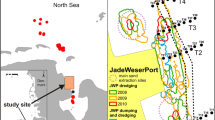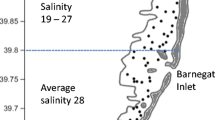Abstract
To determine differences in fish assemblage structures between beach morphodynamic types on an exposed sandy shore, three beach types (reflective, intermediate, and dissipative) were sampled at Fukiagehama Beach, Kyushu Island, southern Japan, in May, August, and November 2006 and 2007. Distinct differences in physical conditions and the amount of major prey invertebrates, such as copepods, mysids, and amphipods, were recognized between the three beach types. The reflective beach was characterized mainly by turbulent swashes, coarse sediment, and a low abundance of major prey invertebrates. In contrast, the dissipative beach was characterized mostly by benign swashes, fine sediment, and a high abundance of prey invertebrates. The intermediate beach tended toward an intermediate condition between the reflective and dissipative beaches. The fish assemblage structures also differed clearly between the three beach types, with species and individual numbers being greatest on the dissipative beach and lowest on the reflective beach. A similarity index indicated differences in species composition of the assemblages between the beach types. Such differences arose primarily from the differential distributions of two dominant trophic groups, zooplankton (mostly copepods) and epibenthic crustacean (mainly mysids and amphipods) feeders, between the beach types, both groups tending to increase in species and individual numbers from the reflective beach to the dissipative beach. In addition, the mean standard length of all fish collected in each month tended to decrease toward the dissipative beach. These results suggested that beach types strongly influence sandy beach fish assemblage structures.








Similar content being viewed by others
References
Baker R, Sheaves M (2006) Visual surveys reveal high densities of large piscivores in shallow estuarine nurseries. Mar Ecol Prog Ser 322:75–82. doi:10.3354/meps323075
Baker R, Sheaves M (2007) Shallow-water refuge paradigm: conflicting evidence from tethering experiments in a tropical estuary. Mar Ecol Prog Ser 349:13–22. doi:10.3354/meps07102
Bale AJ, Kenny AJ (2005) Sediment analysis and seabed characterization. In: Eleftheriou A, Mclntyre A (eds) Methods for the study of Marine Benthos, 3rd edn. Blackwell Science, Oxford, pp 43–86. ISBN 9780632054886
Barros F, Borzone CA, Rosso S (2001) Macroinfauna of six beaches near Guaratuba bay, southern Brazil. Braz Arch Biol Technol 44:351–354
Brazeiro A (2001) Relationship between species richness and morphodynamics in sandy beaches: what are the underlying factors? Mar Ecol Prog Ser 224:35–44. doi:10.3354/meps224035
Chihara M, Murano M (eds) (1997) An illustrated guide to marine plankton in Japan. Tokai University Press, Tokyo, p 1574. ISBN 4486012895
Clark BM (1997) Variation in surf-zone fish community structure across a wave-exposure gradient. Estuar Coast Shelf Sci 44:659–674. doi:10.1006/ecss.1996.0151
Clarke KR, Warwick RM (1994) Changes in marine communities: an approach to statistical analysis and interpretation. Plymouth Marine Laboratory, Natural environment research, Council, England, p 144
Clutter RI (1967) Zonation of nearshore mysids. Ecology 48:200–208. doi:10.2307/1933101
Defeo O, McLachlan A (2005) Patterns, processes and regulatory mechanisms in sandy beach macrofauna: a multi-scale analysis. Mar Ecol Prog Ser 295:1–20. doi:10.3354/meps295001
Defeo O, McLachlan A (2011) Coupling between macrofauna community structure and beach type: a deconstructive meta-analysis. Mar Ecol Prog Ser 433:29–41. doi:10.3354/meps09206
Fisher R, Bellwood DR, Job SD (2000) Development of swimming abilities in reef fish larvae. Mar Ecol Prog Ser 202:163–173. doi:10.3354/meps202163
Fulton CJ, Bellwood DR, Wainwright PC (2001) The relationship between swimming ability and habitat use in wrasses (Labridae). Mar Biol 139:25–33. doi:10.1007/s002270100565
Gibson RN, Ansell AD, Robb L (1993) Seasonal and annual variations in abundance and species composition of fish and macrocrustacean communities on a Scottish sandy beach. Mar Ecol Prog Ser 98:89–105
Gimenez L, Yannicelli B (2000) Longshore patterns of distribution of macroinfauna on a Uruguayan sandy beach: an analysis at different spatial scales and of their potential causes. Mar Ecol Prog Ser 199:111–125. doi:10.3354/meps199111
Harvey CJ (1998) Use of sundy beach habitat by Fundulus majalis, a surf-zone fish. Mar Ecol Prog Ser 164:307–310. doi:10.3354/meps164307
Inoue T, Suda Y, Sano M (2008) Surf zone fishes in an exposed sandy beach at Sanrimatsubara, Japan: does fish assemblage structure differ among microhabitats? Estuar Coast Shelf Sci 77:1–11. doi:10.1016/j.ecss.2007.08.022
Inui R, Nishida T, Onikura N, Eguchi K, Kawagishi M, Nakatani M, Oikawa S (2010) Physical factors influencing immature-fish communities in the surf zones of sandy beaches in northwestern Kyushu Island, Japan. Estuar Coast Shelf Sci 86:467–476. doi:10.1016/j.ecss.2009.09.034
Komar PD (1998) Beach processes and sedimentation, 2nd edn. Prentice Hall, Upper Saddle River, p 544. ISBN 0137549385
Layman CA (2000) Fish assemblage structure of the shallow ocean surf-zone on the eastern shore of Virginia barrier islands. Estuar Coast Shelf Sci 51:201–213. doi:10.1006/ecss.2000.0636
Manderson JP, Pessutti J, Hilbert JG, Juanes F (2004) Shallow water predation risk for a juvenile flatfish (winter flounder; Pseudopleuronectes americanus, Walbaum) in a northwest Atlantic estuary. J Exp Mar Biol Ecol 304:137–157. doi:10.1016/j.jembe.2003.12.004
McLachlan A, Brown AC (2006) The ecology of sandy shores, 2nd edn. Academic Press, Burlington, p 373. ISBN 0123725690
McLachlan A, Dorvlo A (2005) Global patterns in sandy macrobenthic communities. J Coast Res 21:674–687. doi:10.2112/03-0114.1
McLachlan A, Hesp P (1984) Faunal response to morphology and water circulation of a sandy beach with cusps. Mar Ecol Prog Ser 19:133–144
Mikami S, Nakane Y, Sano M (2012) Influence of offshore breakwaters on fish assemblage structure in the surf zone of a sandy beach in Tokyo Bay, central Japan. Fish Sci 78:113–121. doi:10.1007/s12562-011-0421-0
Modde T, Ross ST (1981) Seasonality of fishes occupying a surf zone habitat in the northern Gulf of Mexico. Fish Bull 78:911–922
Nakabo T (ed) (2002) Fishes of Japan with pictorial keys to the species, English edn. Tokai University Press, Tokyo, Japan, p 1800. ISBN 978-4-486-01570-3 C3645
Nakane Y, Suda Y, Hayakawa Y, Ohtomi J, Sano M (2009) Predation pressure for a juvenile fish on an exposed sandy beach: comparison among beach types using tethering experiments. La Mer 46:109–115
Nakane Y, Suda Y, Sano M (2011) Food habits of fishes on an exposed sandy beach at Fukiagehama, South-West Kyushu Island, Japan. Helgol Mar Res 65:123–131. doi:10.1007/s10152-010-0208-1
Nel R, McLachlan A, Winter D (1999) The effect of sand particle size on the burrowing ability of the beach mysid Gasrtosaccus psammodytes Tattersall. Estuar Coast Shelf Sci 48:599–604. doi:10.1006/ecss.1999.0470
Okiyama M (ed) (1988) An atlas of the early stage fishes in Japan. Tokai University Press, Tokyo, p 1154. ISBN 4486009371
Rodil IF, Lastra M, Sanchez-Mata AG (2006) Community structure and intertidal zonation of the macroinfauna in intermediate sandy beaches in temperate latitudes: North coast of Spain. Estuar Coast Shelf Sci 67:267–279. doi:10.1016/j.ecss.2005.11.018
Romer GS (1990) Surf zone fish community and species responses to a wave energy gradient. J Fish Biol 36:279–287. doi:10.1111/j.1095-8649.1990.tb05609.x
Short AD (ed) (1999) Handbook of beach and shoreface morphodynamics. Wiley, London, p 392. ISBN 978-0-471-96570-1
Suda Y, Inoue T, Uchida H (2002) Fish communities in the surf zone of a protected sandy beach at Doigahama, Yamaguchi Prefecture, Japan. Estuar Coast Shelf Sci 55:81–96. doi:10.1006/ecss.2001.0888
Talbot MMB, Bate GC (1987) Distribution patterns of rip frequency and intensity in Algoa Bay, South Africa. Mar Geol 76:319–324. doi:10.1016/0025-3227(87)90037-5
Turner JT (1986) Zooplankton feeding ecology: contents of fecal pellets of the cyclopoid copepods Oncaea venusta, Corycaeus amazonicus, Oithona plumifera, and O. simplex from the Northern Gulf of Mexico. Mar Ecol 7:289–302. doi:10.1111/j.1439-0485.1986.tb00165.x
Watt-Pringle P, Strydom NA (2003) Habitat use by larval fishes in a temperate South African surf zone. Estuar Coast Shelf Sci 58:765–774. doi:10.1016/S0272-7714(03)00183-5
Wright LD, Short AD (1984) Morphodynamic variability of surf zones and beaches: a synthesis. Mar Geol 56:93–118. doi:10.1016/0025-3227(84)90008-2
Zar J (1999) Biostatistical analysis. Prentice Hall, New Jersey, p 929. ISBN: 013081542X
Acknowledgments
We are grateful to J Ohtomi, Y Hayakawa, and students of the Laboratory of Coastal Ecosystem Conservation, National Fisheries University, for assistance with fieldwork. Constructive comments on the manuscript from H Kurokura, G Hardy, and anonymous reviewers were much appreciated. This study was funded by the 21st Century COE Program ‘Biodiversity and Ecosystem Restoration Research Project’ of the Ministry of Education, Culture, Sports, Science, and Technology of Japan.
Author information
Authors and Affiliations
Corresponding author
Additional information
Communicated by M. Huettel.
Appendices
Appendix 1
See Table 4.
Appendix 2
See Table 5.
Appendix 3
See Table 6.
Appendix 4
See Table 7.
Appendix 5
See Table 8.
Appendix 6
See Table 9.
Appendix 7
See Table 10.
Appendix 8
See Table 11.
Appendix 9
See Table 12.
Appendix 10
See Table 13.
Appendix 11
See Table 14.
Appendix 12
See Table 15.
Appendix 13
See Table 16.
Appendix 14
See Table 17.
Appendix 15
See Table 18.
Appendix 16
See Table 19.
Rights and permissions
About this article
Cite this article
Nakane, Y., Suda, Y. & Sano, M. Responses of fish assemblage structures to sandy beach types in Kyushu Island, southern Japan. Mar Biol 160, 1563–1581 (2013). https://doi.org/10.1007/s00227-013-2209-5
Received:
Accepted:
Published:
Issue Date:
DOI: https://doi.org/10.1007/s00227-013-2209-5




